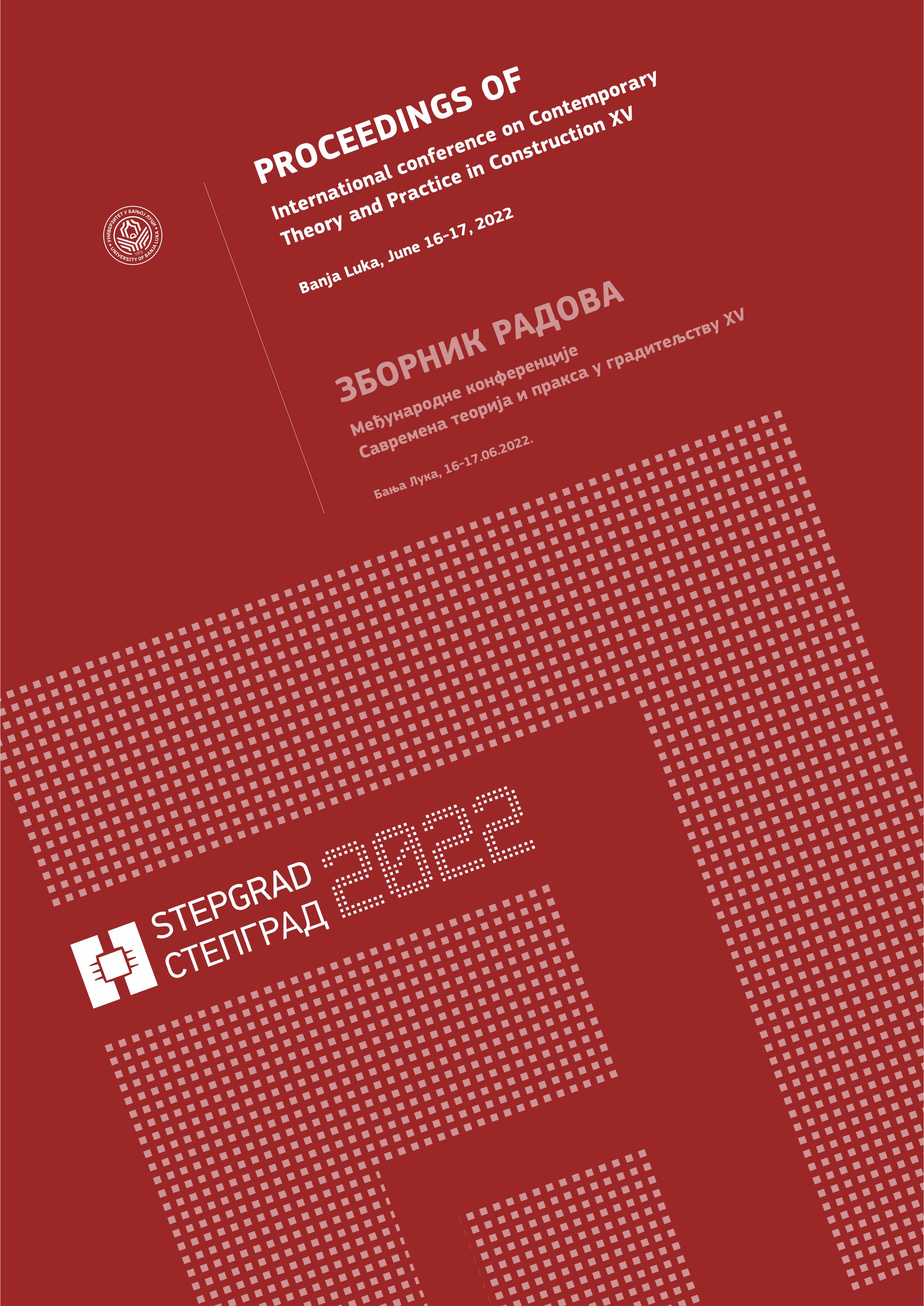ENERGY RENOVATION OF RESIDENTIAL BUILDING ENVELOPE USING ORGANIC MATERIALS FOR THE LEVEL OF COST-OPTIMAL IMPROVEMENT/ UPGRADE IN BOSNIA-HERZEGOVINA AND SERBIA
DOI:
https://doi.org/10.7251/STP2215380SAbstract
Towards building renovation strategies, the research is led by a very deep renovation of residential buildings, which would reduce the energy need for heating below 40 kWh/m2 or create energy savings 60%. The renovation of the building envelope, guided by organic materials (such as wood), which is in the one of key principles in the New Renovation Wave Strategy of the European Union from October 2020, is presented in the paper. Energy saving made by renovating building envelopes using wooden modular systems, are shown through characteristic building on which their application is adequate. Case study from Bosnia and Herzegovina indicate possible energy savings of 81% for residential type Multi-family houses – MFH from period 1961-1970.
References
IRP, Resource Efficiency and Climate Change, 2020, and UN, Environment Emissions Gap Report, 2019.
International energy agency. [On-line] Available: https://www.iea.org/countries/bosnia-and-herzegovina [2019]
International energy agency. [On-line] Available: https://www.iea.org/countries/serbia [2019]
Government of Republika Srpska. Share of energy use and energy sources for Republika Srpska according to the Energy Balance Plan for 2019. [On-line] Available: http://www.vladars.net/sr-SP-Cyrl/Vlada/Ministarstva/mper/Documents/202019_355880114.pdf
European commission, “Renovation Wave Strategy”, 2020, Internet: https://ec.europa.eu/energy/sites/ener/files/eu_renovation_wave_strategy.pdf [2021]
Commission Recommendation on Building Renovation (EU) 2019/786, 2019.
Bosnia and Herzegovina Presidency, (2006, August 25). Energy Community Treaty, no. 09/06, od 25.08.2006.).
Law on Ratification of the Energy Community Treaty between the European Community and the Republic of Albania, the Republic of Bulgaria, Bosnia and Herzegovina, the Republic of Croatia, the Former Yugoslav Republic of Macedonia, the Republic of Montenegro, Romania, the Republic of Serbia and the United Nations Interim Mission in Kosovo. with United Nations Security Council Resolution 1244 [Official Gazette of Republika Srpska, no. 62. from 19. july 2006].
Council of Ministers of the Energy Community. “Deccission D/2015/08/MC-EnC from October 2015.”. Internet: https://www.energy-community.org/legal/decisions.html
European Parliament and the Council. (2012, November 11., L 315) Directive 2012/27/EU from 25 October 2012 on energy efficiency, amending Directives 2009/125/EC and 2010/30/EU and repealing Directives 2004/8/EC and 2006/32/EC. [Official Journal of the European Union]
Ministry of Spatial Planning, Construction and Ecology of the Republic of Srpska. (2019) Draft Strategy for the renovation of buildings in the Republic of Srpska until 2050. in 4th scientific-professional symposium Energy efficiency in building engineering – ENEF. [On-line] Available: http://www.enef.etfbl.net/2019/resources/ENEF_2019_PP22.pdf
Ministry of Spatial Planning, Construction and Ecology of the Republic of Serbia, [On-line]Available:https://www.mgsi.gov.rs/sites/default/files/Predlog%20Dugorocne%20strategije%20PUONFZRS.pdf
Energy Community. [On-line] Available: https://www.energy-community.org/implementation/Bosnia_Herzegovina/CLIM.html (2022)
Energy Community. [On-line] Available: https://www.energy-community.org/implementation/Serbia/CLIM.html (2022)
Government of the Republic of Srpska. Action plan for Energy Efficiency. [On-line] Available: https://www.vladars.net/sr-SP-Cyrl/Vlada/Ministarstva/mper/std/Pages/Akcioni_plan_za_energetsku_efikasnost_.aspx
Ministry of Foreign Trade and Economic Relations of BiH. Energy Efficiency Action Plan in Bosnia and Herzegovina for the period 2019-2021. [On-line] Available: https://ekonsultacije.gov.ba/legislativeactivities/details/113022-
Ministry of Energy and Minning of the Republic of Serbia. The fourth action plan for energy efficiency of the Republic of Serbia until December 31, 2021, https://www.mre.gov.rs/sites/default/files/2021/10/4.apee-26avg2021.pdf
Gajić D., Peulić S., Mavrič T., Sandak A., Tavzes Č., Malešević M., Slijepčević M., Energy Retrofitting Opportunities Using Renewable Materials—Comparative Analysis of the Current Frameworks in Bosnia-Herzegovina and Slovenia. Sustainability 2021, 13, 603. 2021.
Rulebook on energy efficiency of buildings (Official gazette no. 61/2011) [On-line] Available:https://www.mgsi.gov.rs/sites/default/files/PRAVILNIK%20O%20ENERGETSKOJ%20EFIKASNOSTI%20ZGRADA.pdf
Heikkinen, P, Kaufmann, H, Winter, S, Larsen, KE, 2009, EnergyFaçade – prefabricated timber based building system for improving the energy efficiency of the building envelope, Research project from 2008-2009, Woodwisdom-Net, Helsiniki
Ed. Tulamo T.‐S., Cronhjort Y., Riikonen V., Kolehmainen M., Nordberg K., Huß W., SmartTES Innovation in timber construction for the modernisation of the building envelope Book 2 TES Extension. 2014.
Zimmermann M., ECBCS Annex 50 Prefabricated systems for Low Energy Renovation of Residential Buildings: Project Summary Report. 2012.
Arnautović-Aksić, D., Burazor M., Delalić N., Gajić D., Gvero P., Kadrić Dž., Kotur M., Salihović E., Todorović D. i Zagora N., Tipologija stambenih zgrada Bosne i Hercegovine, Sarajevo: Arhitektonski fakultet Univerziteta u Sarajevu , 2016.
Jovanović Popović, M., Ignjatović D., Radivojević A., Rajčić A., Đukanović Lj., Đuković Ignjatović N., Nedić M., National Typology of Residential Buildings in Serbia, Beograd: Faculty of Architecture University of Belgrade, 2013
Loga, T., Stein, B., & Diefenbach, N. (2016). TABULA Building Typologies in 20 European countries − making energy-related features of residential building stocks comparable. Energy and Buildings, http://dx.doi.org/10.1016/j.enbuild.2016.06.094.
Gajić D., Sandak A., Peulić S., Tavzes č., Mavrič T., Prefabricated timber panels application possibilities for the energy refurbishment of residential buildings envelope in Bosnia-Herzegovina and Slovenia. International Conference on contemporary theory and practice in construction XIV. 2020.
Giebeler, G., Fisch R., Krause H., Musso F., Petzinka K.-H. and Rudolphi A., Refurbishment Manual, Basel, Boston, Berlin: Birkhäuser, 2009.
Residential Building Typology of Bosnia and Herzegovina. [On-line] Available: https://episcope.eu/building-typology/country/ba/
Residential Building Typology of Serbia. [On-line] Available: https://episcope.eu/building-typology/country/rs/
Atanasiu, B. (2014). Alleviating fuel poverty in the EU. Buildings Performance Institute Europe (BPIE).
Csoknyai, T., Hrabovszky-Horvátha, S., Georgiev, Z., Jovanovic-Popovic, M., & all. (2016). Building stock characteristics and energy performance of residential buildings in Eastern-European countries. Energy and Buildings, http://dx.doi.org/10.1016/j.enbuild.2016.06.062
Huseinbašić E., Jojić A., Petrović S., Jović D., Radaković M., (2020) Desing for the renovation of the building envelope; student seminar paper. University of Banja Luka; Faculty of Architecture, Civil Engineering and Geodesy.

